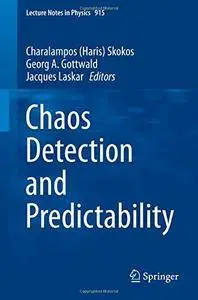Chaos Detection and Predictability
Springer | Physics | April 4 2016 | ISBN-10: 3662484080 | 269 pages | pdf | 18.89 mb
Springer | Physics | April 4 2016 | ISBN-10: 3662484080 | 269 pages | pdf | 18.89 mb
Editors: Skokos, Charalampos (Haris), Gottwald, Georg A., Laskar, Jacques (Eds.)
Edited and authored by pioneers in the field
Comprehensive and self-contained introduction and overview
Useful as text for advanced courses and for self-study
Distinguishing chaoticity from regularity in deterministic dynamical systems and specifying the subspace of the phase space in which instabilities are expected to occur is of utmost importance in as disparate areas as astronomy, particle physics and climate dynamics.
To address these issues there exists a plethora of methods for chaos detection and predictability. The most commonly employed technique for investigating chaotic dynamics, i.e. the computation of Lyapunov exponents, however, may suffer a number of problems and drawbacks, for example when applied to noisy experimental data.
In the last two decades, several novel methods have been developed for the fast and reliable determination of the regular or chaotic nature of orbits, aimed at overcoming the shortcomings of more traditional techniques. This set of lecture notes and tutorial reviews serves as an introduction to and overview of modern chaos detection and predictability techniques for graduate students and non-specialists.
The book covers theoretical and computational aspects of traditional methods to calculate Lyapunov exponents, as well as of modern techniques like the Fast (FLI), the Orthogonal (OFLI) and the Relative (RLI) Lyapunov Indicators, the Mean Exponential Growth factor of Nearby Orbits (MEGNO), the Smaller (SALI) and the Generalized (GALI) Alignment Index and the ‘0-1’ test for chaos.
Number of Illustrations and Tables
78 b/w illustrations, 44 illustrations in colour
Topics
Nonlinear Dynamics
Mathematical Methods in Physics
Mathematical Applications in the Physical Sciences
Extraterrestrial Physics, Space Sciences
Earth System Sciences
Click Here to Buy the Hardcover from Springer
Click Here for More books



